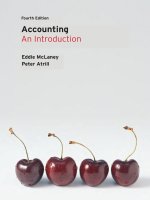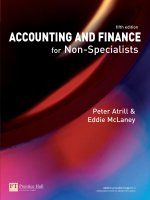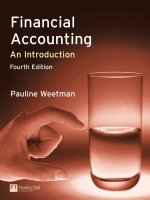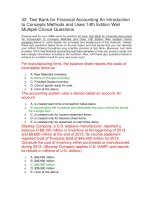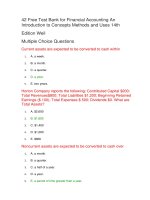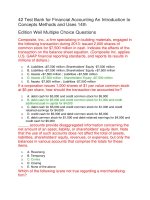Accounting an introduction 4th ed by peter atrill
Bạn đang xem bản rút gọn của tài liệu. Xem và tải ngay bản đầy đủ của tài liệu tại đây (11.16 MB, 833 trang )
Accounting
An Introduction
Fourth Edition
Fourth Edition
Accounting
An Introduction
Eddie McLaney Peter Atrill
Fourth Edition
Audience
Features
Suitable for all those studying an introductory course
in accounting, who are seeking an understanding of
basic principles and underlying concepts without
detailed technical knowledge.
●
●
Authors
Eddie McLaney is Visiting Fellow in Accounting and
Finance at the University of Plymouth.
Peter Atrill is a freelance academic and author
working with leading institutions in the UK, Europe
and SE Asia. He was previously Head of Business
and Management at the University of Plymouth
Business School.
●
●
●
Visit the companion website at
www.pearsoned.co.uk/mclaney
●
●
●
Progress checks: numerous activities and
exercises enable you to constantly test
your understanding and reinforce learning.
Lively and relevant examples from the real
world demonstrate the practical application
and value of concepts and techniques learnt.
Interactive ‘open learning’ style is ideal for
self study.
Decision making focus on the use of
accounting information rather than its
preparation is highly appropriate for
tomorrow’s business managers.
Fully incorporates International Financial
Reporting Standards, which are crucial in
the European and world business arena.
Key terms, glossary and bulleted summaries
are excellent revision aids.
Clearer distinctions between process
costing and job order costing.
Eddie McLaney
Peter Atrill
9780273711360_04_COVER.indd 1
Eddie McLaney
Peter Atrill
More extensive coverage of corporate
governance and ethics issues.
The text is supported by MyAccountingLab, a completely new type of educational resource. MyAccountingLab
complements student learning by presenting the user with a study plan that adapts and customises to the student’s
individual requirements as they progress through online tests. Students can also practice problems before taking
tests, and because most of these are algorithmically driven, they can practice over and over again without repetition.
Additionally, students have access to an eBook, animated guides to various key topics, and guided solutions, all of
which are designed to help them overcome the most difficult concepts. Both students and lecturers have access to
gradebooks that allow them to track progress, and lecturers will have the ability to create new tests and activities
using the large number of problems available in the question database.
an imprint of
Accounting An Introduction
Accounting: An Introduction 4th edition is renowned for its clear, accessible and uncluttered style. It provides a
comprehensive introduction to the main principles of financial accounting, management accounting, and the core
elements of financial management. With a clear and unequivocal focus on how accounting information can be used
to improve the quality of decision making by managers, combined with a strong practical emphasis, this book
provides the ideal grounding for a career in management.
www.pearson-books.com
1/8/07 14:52:27
ACCA_A01.qxd
7/08/2007
11:14
Page i
Accounting
An Introduction
Visit the Accounting: An Introduction, fourth edition Companion Website at
www.pearsoned.co.uk/mclaney to find valuable student learning material
including:
●
●
●
●
●
Multiple choice questions to help test your learning
Additional exercises and review questions
Solutions to end of chapter review questions
Links to relevant sites on the web
An online glossary to explain key terms
ACCA_A01.qxd
7/08/2007
11:14
Page ii
We work with leading authors to develop the strongest
educational materials in Accounting, bringing cutting-edge
thinking and best learning practice to a global market.
Under a range of well-known imprints, including
Financial Times Prentice Hall, we craft high quality print
and electronic publications which help readers to
understand and apply their content, whether studying
or at work.
To find out more about the complete range of our
publishing, please visit us on the World Wide Web at:
www.pearsoned.co.uk
ACCA_A01.qxd
7/08/2007
11:14
Page iii
4th
edition
Accounting
An Introduction
Eddie McLaney
and
Peter Atrill
ACCA_A01.qxd
7/08/2007
11:14
Page iv
Pearson Education Limited
Edinburgh Gate
Harlow
Essex CM20 2JE
England
and Associated Companies throughout the world
Visit us on the World Wide Web at:
www.pearsoned.co.uk
First published 1999 by Prentice Hall Europe
Second edition published 2002
Third edition published 2005
Fourth edition published 2008
© Prentice Hall Europe 1999
© Pearson Education Limited 2002, 2005, 2008
The rights of Eddie McLaney and Peter Atrill to be identified as authors of this work have
been asserted by them in accordance with the Copyright, Designs and Patents Act 1988.
All rights reserved. No part of this publication may be reproduced, stored in a retrieval
system, or transmitted in any form or by any means, electronic, mechanical, photocopying,
recording or otherwise, without either the prior written permission of the publisher or a
licence permitting restricted copying in the United Kingdom issued by the Copyright
Licensing Agency Ltd, Saffron House, 6–10 Kirby Street, London EC1N 8TS.
All trademarks used herein are the property of their respective owners. The use of any
trademark in this text does not vest in the author or publisher any trademark ownership
rights in such trademarks, nor does the use of such trademarks imply any affiliation with
or endorsement of this book by such owners.
ISBN 978-0-273-71136-0
British Library Cataloguing-in-Publication Data
A catalogue record for this book is available from the British Library
10 9 8 7 6 5 4 3 2 1
11 10 09 08 07
Typeset in 9.5/12.5pt Stone Serif by 35
Printed and bound by Mateu Cromo Artes Graficas, Spain
The publisher’s policy is to use paper manufactured from sustainable forests.
ACCA_A01.qxd
7/08/2007
11:14
Page v
Brief contents
Preface • How to use this book • Guided tours • Acknowledgements
1
Introduction to accounting and finance
Part 1 Financial accounting
2
3
4
5
6
7
Measuring and reporting financial position
Measuring and reporting financial performance
Accounting for limited companies (1)
Accounting for limited companies (2)
Measuring and reporting cash flows
Analysing and interpreting financial statements
xxi–xxviii
1
35
37
71
115
159
192
221
Part 2 Management accounting
277
8
9
10
11
12
13
279
Relevant costs for decision making
Cost–volume–profit analysis
Full costing
Costing and pricing in a competitive environment
Budgeting
Accounting for control
297
332
372
430
470
Part 3 Financial management
507
14 Making capital investment decisions
15 Financing the business
16 Managing working capital
509
Part 4 Supplementary information
657
Appendix A
Appendix B
Appendix C
Appendix D
Appendix E
Appendix F
659
Index
Recording financial transactions
Glossary of key terms
Solutions to self-assessment questions
Solutions to review questions
Solutions to selected exercises
Present value table
566
614
677
693
709
723
787
789
ACCA_A01.qxd
7/08/2007
11:14
Page vi
ACCA_A01.qxd
7/08/2007
11:14
Page vii
Detailed contents
Preface
How to use this book
Guided tour of the book
Guided tour MyAccountingLab
Acknowledgements
1
Introduction to accounting and finance
Introduction
Learning outcomes
What are accounting and finance?
Who are the users of accounting information?
The conflicting interests of users
How useful is accounting information?
Evidence on the usefulness of accounting
Providing a service
But . . . is it material?
Weighing up the costs and benefits
Accounting as an information system
Management and financial accounting
Scope of this book
Has accounting become too interesting?
The changing face of accounting
Why do I need to know anything about accounting and finance?
Accounting for business
What is the purpose of a business?
What kinds of business ownership exist?
Sole proprietorship
Partnership
Limited company
How are businesses organised?
How are businesses managed?
What is the financial objective of a business?
Balancing risk and return
Not-for-profit organisations
Summary
Key terms
References
Further reading
Review questions
xxi
xxii
xxiv
xxvi
xxviii
1
1
1
2
3
5
5
6
7
8
9
11
13
15
15
16
17
18
18
19
19
20
20
22
24
25
28
28
30
32
32
32
33
ACCA_A01.qxd
viii
7/08/2007
11:14
Page viii
CONTENTS
Part 1 Financial accounting
2 Measuring and reporting financial position
37
Introduction
Learning outcomes
37
37
The major financial statements – an overview
The balance sheet
Assets
Claims
38
42
42
44
The effect of trading operations on the balance sheet
The classification of assets
Current assets
Non-current assets
47
49
50
50
The classification of claims
Balance sheet layouts
The balance sheet and time
Accounting conventions and the balance sheet
Business entity convention
Historic cost convention
Prudence convention
Going concern convention
Dual aspect convention
52
52
55
55
55
56
56
57
57
Money measurement
Goodwill and brands
Human resources
Monetary stability
58
59
60
60
Valuing assets on the balance sheet
Tangible non-current assets (property, plant and equipment)
Intangible non-current assets
The impairment of non-current assets
Inventories (stock)
61
61
63
63
64
Interpreting the balance sheet
65
Summary
Key terms
Further reading
Review questions
Exercises
66
67
67
68
68
3 Measuring and reporting financial performance
71
Introduction
Learning outcomes
71
71
The income statement
The income statement and the balance sheet
Income statement layout
Some further issues
Cost of sales
72
73
74
75
76
ACCA_A01.qxd
7/08/2007
11:14
Page ix
CONTENTS
Classification of expenses
The accounting period
77
78
Recognising revenue
Long-term contracts
Services
79
80
81
Recognising expenses
When the expense for the period is more than the cash paid
during the period
When the amount paid during the year is more than the full
expense for the period
Profit, cash and accruals accounting
82
Depreciation
Tangible non-current assets (property, plant and equipment)
Depreciating intangible assets
Depreciation and the replacement of non-current assets
Depreciation and judgement
87
87
93
94
95
83
85
86
Costing inventories
First in, first out (FIFO)
Last in, first out (LIFO)
Weighted average cost (AVCO)
Inventories – some further issues
97
97
98
98
100
Dealing with trade receivables’ problems
Interpreting the income statement
101
107
Summary
Key terms
Further reading
Review questions
Exercises
107
109
109
110
110
4 Accounting for limited companies (1)
115
Introduction
Learning outcomes
115
115
The main features of limited companies
Legal nature
Perpetual life
Limited liability
Legal safeguards
Public and private companies
Taxation
Transferring share ownership: the role of the Stock Exchange
116
116
116
117
119
119
121
122
Managing a company
Strengthening the framework of rules
The Combined Code
123
124
124
Financing limited companies
The owners’ claim
The basic division
128
128
129
ix
ACCA_A01.qxd
x
7/08/2007
11:14
Page x
CONTENTS
Share capital
Reserves
130
131
Altering the nominal value of shares
Bonus shares
Share capital jargon
133
134
136
Raising share capital
Borrowings
Withdrawing equity
The main financial statements
The income statement
The balance sheet
136
137
139
142
144
144
Dividends
Accounting for groups of companies
145
145
Summary
Key terms
Reference
Further reading
Review questions
Exercises
150
152
152
152
153
153
5 Accounting for limited companies (2)
159
Introduction
Learning outcomes
159
159
The directors’ duty to account
The need for accounting rules
Sources of accounting rules
Presenting the financial statements
Income statement
Balance sheet
Statement of changes in equity
Cash flow statement
Explanatory notes
General points
160
161
161
164
165
166
166
168
168
168
The framework of principles
The IASB framework
169
169
The auditors’ role
Directors’ report
Segmental financial reports
Segmental reporting rules
Segmental disclosure
Problems of segmental reporting
170
171
171
172
173
174
Narrative reporting
The OFR framework
The business review and RS 1
175
176
179
Summary financial statements
Creative accounting
Creative accounting methods
180
180
180
ACCA_A01.qxd
7/08/2007
11:14
Page xi
CONTENTS
Checking for creative accounting
Creative accounting and economic growth
Summary
Key terms
Further reading
Review questions
Exercises
6 Measuring and reporting cash flows
184
185
185
187
187
188
188
192
Introduction
Learning outcomes
192
192
The cash flow statement (or statement of cash flows)
Why is cash so important?
The main features of the cash flow statement
A definition of cash and cash equivalents
The relationship between the primary financial statements
The form of the cash flow statement
The normal direction of cash flows
193
194
195
195
196
197
199
Preparing the cash flow statement
Deducing net cash flows from operating activities
Deducing the other areas of the cash flow statement
201
201
204
What does the cash flow statement tell us?
208
Summary
Key terms
Further reading
Review questions
Exercises
211
212
212
213
213
7 Analysing and interpreting financial statements
221
Introduction
Learning outcomes
221
221
Financial ratios
Financial ratio classifications
The need for comparison
Past periods
Similar businesses
Planned performance
222
223
223
224
224
224
Calculating the ratios
A brief overview
Profitablility
Return on ordinary shareholders’ funds (ROSF)
Return on capital employed (ROCE)
Operating profit margin
Gross profit margin
225
227
228
228
229
230
231
Efficiency
Average inventories turnover period
Average settlement period for trade receivables
233
233
234
xi
ACCA_A01.qxd
xii
7/08/2007
11:14
Page xii
CONTENTS
Average settlement period for trade payables
Sales revenue to capital employed
Sales revenue per employee
235
236
237
Relationship between profitablility and efficiency
Liquidity
Current ratio
Acid test ratio
Cash generated from operations to maturing obligations
238
240
240
241
241
Financial gearing
Gearing ratio
Interest cover ratio
242
244
245
Investment ratios
Dividend payout ratio
Dividend yield ratio
Earnings per share
Cash generated from operations per share
Price/earnings (P/E) ratio
248
248
249
250
250
251
Financial ratios and the problem of overtrading
Trend analysis
Using ratios to predict financial failure
Using single ratios
Using combinations of ratios
Z score models
256
258
260
260
262
263
Limitations of ratio analysis
264
Summary
Key terms
References
Further reading
Review questions
Exercises
266
268
268
268
269
269
Part 2 Management accounting
8 Relevant costs for decision making
279
Introduction
Learning outcomes
279
279
What is meant by ‘cost’?
Relevant costs: opportunity and outlay costs
Sunk costs and committed costs
Qualitative factors of decisions
280
282
286
287
Summary
Key terms
Further reading
Review questions
Exercises
289
290
290
291
291
ACCA_A01.qxd
7/08/2007
11:14
Page xiii
CONTENTS
9 Cost–volume–profit analysis
297
Introduction
Learning outcomes
297
297
The behaviour of costs
Fixed costs
Variable costs
Semi-fixed (semi-variable) costs
Estimating semi-fixed (semi-variable) costs
298
298
300
301
302
Finding the break-even point
Contribution
Margin of safety
Operating gearing
Operating gearing and its effect on profit
303
307
308
311
311
Profit–volume charts
The economist’s view of the break-even chart
Failing to break even
Weaknesses of break-even analysis
Using contribution to make decisions: marginal analysis
Accepting/rejecting special contracts
The most efficient use of scarce resources
Make-or-buy decisions
Closing or continuation decisions
Summary
Key terms
Further reading
Review questions
Exercises
313
313
315
315
317
318
319
322
323
325
326
326
327
327
10 Full costing
332
Introduction
Learning outcomes
Why do managers want to know the full cost?
What is full costing?
Single-product businesses
Multi-product businesses
Direct and indirect costs
Job costing
Full (absorption) costing and the behaviour of costs
The problem of indirect costs
332
332
333
334
334
335
336
337
338
340
Overheads as service renderers
Job costing: a worked example
Selecting a basis for charging overheads
Segmenting the overheads
Dealing with overheads on a departmental basis
Batch costing
Full (absorption) cost as the break-even price
The forward-looking nature of full (absorption) costing
340
340
344
347
348
358
359
359
xiii
ACCA_A01.qxd
xiv
7/08/2007
11:14
Page xiv
CONTENTS
Using full (absorption) cost information
Criticisms of full (absorption) costing
Full (absorption) costing versus variable costing
Which method is better?
360
362
362
363
Summary
Key terms
References
Further reading
Review questions
Exercises
364
366
366
366
367
367
11 Costing and pricing in a competitive environment
372
Introduction
Learning outcomes
372
372
Costing and the changed business environment
Costing and pricing in the traditional way
Costing and pricing in the new environment
373
373
374
Activity-based costing
An alternative approach to full costing
What drives the costs?
Cost pools
ABC and service industries
Criticisms of ABC
374
375
376
376
377
381
Other approaches to cost management
Total (or whole) life-cycle costing
Target costing
Costing quality control
Kaizen costing
Value chain analysis
Benchmarking
385
385
388
389
390
390
392
Non-financial measures of performance
The Balanced Scorecard
393
394
Measuring shareholder value
The quest for shareholder value
How can shareholder value be created?
The need for new measures
Economic value added (EVA®)
401
401
401
402
403
Pricing
Economic theory
Some practical considerations
Full cost (cost-plus) pricing
Pricing on the basis of relevant/marginal cost
Target pricing
Pricing strategies
409
409
416
417
420
422
422
Summary
Key terms
References
423
425
425
ACCA_A01.qxd
7/08/2007
11:14
Page xv
CONTENTS
Further reading
Review questions
Exercises
12 Budgeting
425
426
426
430
Introduction
Learning outcomes
430
430
How budgets link with strategic plans and objectives
Collecting information on performance and exercising control
431
432
Time horizon of plans and budgets
Limiting factors
Budgets and forecasts
Periodic and continual budgets
How budgets link to one another
How budgets help managers
The budget-setting process
Using budgets in practice
Incremental and zero-base budgeting
Preparing the cash budget
Preparing other budgets
Activity-based budgeting
Non-financial measures in budgeting
Budgets and management behaviour
Who needs budgets?
Beyond conventional budgeting
Long live budgets!
432
434
434
434
435
437
440
443
446
447
451
454
455
455
456
457
460
Summary
Key terms
References
Further reading
Review questions
Exercises
461
462
462
462
463
463
13 Accounting for control
470
Introduction
Learning outcomes
470
470
Budgeting for control
Types of control
Variances from budget
Flexing the budget
Sales volume variance
Sales price variance
Materials variance
Labour variances
Fixed overhead variance
471
472
473
474
474
477
478
479
480
Reasons for adverse variances
Non-operating-profit variances
Investigating variances
484
486
486
xv
ACCA_A01.qxd
xvi
7/08/2007
11:14
Page xvi
CONTENTS
Compensating variances
Making budgetary control effective
Behavioural issues
The impact of management style
Reservations about the Hopwood study
Failing to meet the budget
489
490
490
491
492
492
Standard quantities and cost
Setting standards
What kinds of standards should be used?
Information gathering
The learning-curve effect
494
494
494
495
496
Other uses for standard costing
Some problems . . .
The new business environment
497
497
498
Summary
Key terms
References
Further reading
Review questions
Exercises
499
501
501
501
502
502
Part 3 Financial management
14 Making capital investment decisions
509
Introduction
Learning outcomes
509
509
The nature of investment decisions
Investment appraisal methods
Accounting rate of return (ARR)
ARR and ROCE
Problems with ARR
510
511
513
515
515
Payback period (PP)
Problems with PP
518
520
Net present value (NPV)
Interest lost
Risk
Inflation
What will a logical investor do?
Using discount tables
Why NPV is better
NPV’s wider application
522
523
523
524
524
527
529
530
Internal rate of return (IRR)
Problems with IRR
530
533
Some practical points
534
ACCA_A01.qxd
7/08/2007
11:14
Page xvii
CONTENTS
Investment appraisal in practice
Dealing with risk
Assessing the level of risk
Reacting to the level of risk
537
541
541
551
Managing investment projects
Stage 1: Determine investment funds available
Stage 2: Identify profitable project opportunities
Stage 3: Evaluate the proposed project
Stage 4: Approve the project
Stage 5: Monitor and control the project
552
553
554
554
555
555
Summary
Key terms
References
Further reading
Review questions
Exercises
557
559
559
559
560
560
15 Financing the business
566
Introduction
Learning outcomes
566
566
Sources of finance
Sources of internal finance
Long-term sources of internal finance
Retained profits
567
567
568
568
Short-term sources of internal finance
Tighter credit control
Reducing inventories levels
Delaying payment to trade payables
569
569
570
570
Sources of external finance
Long-term sources of external finance
Ordinary shares
Preference shares
Loans (borrowings)
Finance leases and sale-and-leaseback arrangements
Hire purchase
570
570
571
572
573
580
582
Gearing and the long-term financing decision
Share issues
Rights issue
Offer for sale and public issue
Private placing
Bonus issue
583
586
586
589
590
590
The role of the Stock Exchange
Advantages of a listing
Disadvantages of a listing
590
592
594
Alternative Investment Market
Short-term sources of external finance
Bank overdraft
596
597
597
xvii
ACCA_A01.qxd
xviii
7/08/2007
11:14
Page xviii
CONTENTS
Debt factoring
Invoice discounting
597
598
Long-term versus short-term borrowing
Providing long-term finance for the small business
Venture capital
Business angels
Government assistance
600
601
601
603
603
Summary
Key terms
Further reading
Review questions
Exercises
605
607
607
608
608
16 Managing working capital
614
Introduction
Learning outcomes
614
614
The nature and purpose of working capital
Managing working capital
615
616
The scale of working capital
Managing inventories
Budgeting future demand
Financial ratios
Recording and reordering systems
Levels of control
Inventories management models
616
618
620
620
620
622
622
Managing receivables
Which customers should receive credit and how much should
they be offered?
Length of credit period
Cash discounts
Debt factoring and invoice discounting
Collection policies and reducing the risk of non-payment
627
627
629
631
632
632
Managing cash
Why hold cash?
How much cash should be held?
Controlling the cash balance
Cash budgets and managing cash
Operating cash cycle
Cash transmission
Bank overdrafts
635
635
636
636
638
638
641
642
Managing trade payables
Controlling trade payables
642
643
Working capital problems of the small business
Managing inventories
Credit management
Managing cash
Managing credit suppliers
644
644
644
645
645
ACCA_A01.qxd
7/08/2007
11:14
Page xix
CONTENTS
Summary
Key terms
Reference
Further reading
Review questions
Exercises
646
648
648
648
649
649
Part 4 Supplementary information
Appendix A Recording financial transactions
Introduction
Learning outcomes
The basics of double-entry bookkeeping
Recording trading transactions
Balancing acccounts and the trial balance
Preparing the financial statements (final accounts)
The ledger and its division
660
662
665
669
672
Summary
Key terms
Further reading
Exercises
673
673
674
675
Appendix B
Appendix C
Appendix D
Appendix E
Appendix F
Index
659
659
659
Glossary of key terms
Solutions to self-assessment questions
Solutions to review questions
Solutions to selected exercises
Present value table
677
693
709
723
787
789
xix
ACCA_A01.qxd
7/08/2007
11:14
Page xx
Supporting resources
Visit www.pearsoned.co.uk/mclaney to find valuable online resources
Companion Website for students
● Multiple choice questions to help test your learning
● Additional exercises and review questions
● Solutions to end of chapter review questions
● Links to relevant sites on the web
● An online glossary to explain key terms
For instructors
● Complete, downloadable Instructor’s Manual
● PowerPoint slides that can be downloaded and used for presentations
● Case study material with solutions
● Progress tests, consisting of various questions and exercise material with
solutions
● Tutorial/seminar questions and solutions
● Solutions to end of chapter review questions
Also: The Companion Website provides the following features:
● Search tool to help locate specific items of content
● E-mail results and profile tools to send results of quizzes to instructors
● Online help and support to assist with website usage and troubleshooting
For more information please contact your local Pearson Education sales
representative or visit www.pearsoned.co.uk/mclaney
ACCA_A01.qxd
7/08/2007
11:14
Page xxi
Preface
This text provides a comprehensive introduction to financial accounting, management
accounting and core elements of financial management. It is aimed both at students
who are not majoring in accounting or finance and at those who are. Those studying
introductory level accounting and/or financial management as part of their course in
business, economics, hospitality management, tourism, engineering or some other area
should find that the book provides complete coverage of the material at the level
required. Students who are majoring in either accounting or finance should find the
book useful as an introduction to the main principles, which can serve as a foundation
for further study. The text does not focus on technical issues, but rather examines basic
principles and underlying concepts. The primary concern throughout is the ways
in which financial statements and information can be used to improve the quality
of decision making. To reinforce this practical emphasis, there are, throughout the
text, numerous illustrative extracts with commentary from real life, including company reports, survey data and other sources.
In this fourth edition we have taken the opportunity to make improvements that
have been suggested by students and lecturers who used the previous edition. We have
also brought up to date and expanded the number of examples from real life. From
2005, most of the larger UK companies have had to adopt a new set of international
rules relating to their main financial statements. These new rules form the basis of the
section of the book that deals specifically with accounting for limited companies.
The text is written in an ‘open-learning’ style. This means that there are numerous
integrated activities, worked examples and questions throughout the text to help you
to understand the subject fully. You are encouraged to interact with the material and
to check your progress continually. Irrespective of whether you are using the book as
part of a taught course or for personal study, we have found that this approach is more
‘user friendly’ and makes it easier for you to learn.
We recognise that most readers will not have studied accounting or finance before,
and we have therefore tried to write in a concise and accessible style, minimising the
use of technical jargon. We have also tried to introduce topics gradually, explaining
everything as we go. Where technical terminology is unavoidable we try to provide
clear explanations. In addition, you will find all of the key terms highlighted in the
text. These are then listed at the end of each chapter with a page reference. They are
also listed alphabetically, with a concise definition, in the glossary given in Appendix
B towards the end of the book. This should provide a convenient point of reference
from which to revise.
A further important consideration in helping you to understand and absorb the topics covered is the design of the text itself. The page layout and colour scheme have
been carefully considered to allow for the easy navigation and digestion of material.
The layout features a large page format, an open design, and clear signposting of the
various features and assessment material.
More detail about the nature and use of these features is given in the ‘How to use
this book’ section; and the main points are also summarised, using example pages from
the text, in the guided tour.
We hope that you will find the book readable and helpful.
Eddie McLaney
Peter Atrill
ACCA_A01.qxd
7/08/2007
11:14
Page xxii
How to use this book
We have organised the chapters to reflect what we consider to be a logical sequence
and, for this reason, we suggest that you work through the text in the order in which
it is presented. We have tried to ensure that earlier chapters do not refer to concepts or
terms that are not explained until a later chapter. If you work through the chapters in
the ‘wrong’ order, you will probably encounter concepts and terms that were explained
previously.
Irrespective of whether you are using the book as part of a lecture/tutorial-based
course or as the basis for a more independent mode of study, we advocate following
broadly the same approach.
Integrated assessment material
Interspersed throughout each chapter are numerous Activities. You are strongly advised
to attempt all of these questions. They are designed to simulate the sort of quick-fire
questions that your lecturer might throw at you during a lecture or tutorial. Activities
serve two purposes:
●
●
To give you the opportunity to check that you understand what has been covered
so far.
To encourage you to think about the topic just covered, either to see a link between
that topic and others with which you are already familiar, or to link the topic just
covered to the next.
The answer to each Activity is provided immediately after the question. This answer
should be covered up until you have deduced your solution, which can then be compared with the one given.
Towards the middle/end of each chapter there is a Self-assessment question. This
is more comprehensive and demanding than any of the Activities, and is designed to
give you an opportunity to check and apply your understanding of the core coverage
of the chapter. The solution to each of these questions is provided in Appendix C at the
end of the book. As with the Activities, it is important that you attempt each question
thoroughly before referring to the solution. If you have difficulty with a self-assessment
question, you should go over the relevant chapter again.
End-of-chapter assessment material
At the end of each chapter there are four Review questions. These are short questions
requiring a narrative answer or discussion within a tutorial group. They are intended
to help you assess how well you can recall and critically evaluate the core terms and
concepts covered in each chapter. Answers to these questions are provided in the student
access Companion Website. At the end of each chapter, except for Chapter 1, there are
ACCA_A01.qxd
24/08/2007
17:11
Page xxiii
HOW TO USE THIS BOOK
eight Exercises. These are mostly computational and are designed to reinforce your
knowledge and understanding. Exercises are graded as ‘basic’ and ‘more advanced’,
according to their level of difficulty. The basic-level questions are fairly straightforward;
the more advanced ones can be quite demanding but are capable of being successfully
completed if you have worked conscientiously through the chapter and have attempted
the basic exercises. Solutions to five of the exercises in each chapter are provided in
Appendix D at the end of the book. A coloured exercise number identifies these five questions. Here, too, a thorough attempt should be made to answer each exercise before
referring to the solution. Solutions to the other three exercises and to the review questions
in each chapter are provided in a separate Instructors’ Manual.
To familiarise yourself with the main features and how they will benefit your study
from this text, an illustrated Guided tour is provided on pages xxiv–xxv.
Content and structure
The text comprises 16 chapters organised into three core parts: financial accounting,
management accounting and financial management. A brief introductory outline of the
coverage of each part and its component chapters is given in the opening double-page
spread which precedes each part.
The market research for this text revealed a divergence of opinions, given the target
market, on whether or not to include material on double-entry bookkeeping techniques.
So as to not interrupt the flow and approach of the financial accounting chapters,
Appendix A on recording financial transactions (including Activities and three Exercise
questions) has been placed in Part 4.
MyAccountingLab
Remember to create your own
personalised Study Plan
MyAccountingLab supports this book. This banner reminds students to complete the
chapter pre-test to create their personal Study Plan. The results of the test determine
the Study Plan going forward.
Now check your progress in
your personal Study Plan
This banner reminds students to complete the chapter post-test in MyAccountingLab
to track their progress and mastery of the topics included in each chapter. Their Study
plan will adapt according to the results of the test.
This icon indicates that there is a Key Concept Animation relevant to the
topic covered in the text at that point. Animations of all the Key Concepts
are accessible through MyAccountingLab.
This icon indicates that there is an interactive Study Guide covering the topic
at hand available in MyAccountingLab. The Study Guide contains diagrams,
video clips and short self test quizzes designed to guide and reinforce the
student's learning.
xxiii
ACCA_A01.qxd
7/08/2007
11:14
Page xxiv
Guided tour of the book
38
CHAPTER
1
CHAPTER 2
MEASURING AND REPORTING FINANCIAL POSITION
The major financial statements – an overview
The major financial accounting statements aim to provide a picture of the financial
position and performance of a business. To achieve this, a business’s accounting system will normally produce three particular statements on a regular, recurring basis.
These three are concerned with answering the following questions:
Introduction to accounting
and finance
●
●
●
What cash movements (that is, cash in and cash out) took place over a particular
period?
How much wealth (that is, profit) was generated, or lost, by the business over that
period? (Profit (loss) is defined as the increase (decrease) in wealth arising from
trading activities.)
What is the accumulated wealth of the business at the end of that period and what
form does the wealth take?
To address each of the above questions, there is a separate financial statement. The
financial statements are:
Introduction
➔
➔
➔
n this opening chapter we begin by considering the roles of accounting and finance. We
shall see that both can be valuable tools for decision-making purposes. We shall identify
the main users of accounting and financial information and discuss the ways in which this
information can improve the quality of decisions that those users make. In subsequent
chapters, we develop this decision-making theme by considering in some detail the kinds
of financial reports and methods used to aid decision making.
Since this book is concerned with accounting and financial decision making for privatesector businesses, we shall devote some time to examining the business environment. We
shall, therefore, consider the purpose of a private-sector business, the main forms of business
enterprise and the ways in which a business may be structured. We shall also consider
what the key financial objective of a business is likely to be. These factors are important as
they all exert an influence on the kind of accounting and financial information produced.
I
●
●
●
the cash flow statement
the income statement (also known as the profit and loss account)
the balance sheet (also known as the statement of financial position).
When taken together, they provide an overall picture of the financial health of the
business.
Perhaps the best way to introduce these financial statements is to look at an example
of a very simple business. From this we shall be able to see the sort of information that
each of the statements can usefully provide. It is, however, worth pointing out that,
while a simple business is our starting point, the principles that we consider apply
equally to the largest and most complex businesses. This means that we shall frequently
encounter these principles again in later chapters.
Example 2.1
Paul was unemployed and unable to find a job. He therefore decided to embark
on a business venture. Christmas was approaching, and so he decided to buy gift
wrapping paper from a local supplier and to sell it on the corner of his local high
street. He felt that the price of wrapping paper in the high street shops was
excessive. This provided him with a useful business opportunity.
He began the venture with £40 in cash. On Monday, Paul’s first day of trading,
he bought wrapping paper for £40 and sold three-quarters of it for £45 cash.
Learning outcomes
When you have completed this chapter, you should be able to:
●
Explain the nature and roles of accounting and finance.
●
Identify the main users of financial information and discuss their needs.
●
Identify and discuss the characteristics that make accounting
information useful.
●
Explain the purpose of a business and describe how businesses are
organised and structured.
●
What cash movements took place during Monday?
For Monday, a cash flow statement showing the cash movements for the day
can be prepared as follows:
Cash flow statement for Monday
Opening balance (cash introduced)
Add Cash from sales of wrapping paper
Remember to create your own
personalised Study Plan
Less Cash paid to buy wrapping paper
Closing balance of cash
Key terms The key concepts
and techniques in each
chapter are highlighted in
colour where they are first
introduced, with an adjacent
icon in the margin to help you
refer back to them.
Examples At frequent
intervals throughout most
chapters, there are numerical
examples that give you stepby-step workings to follow
through to the solution.
£
40
45
85
40
45
Introductions A brief introduction, detailing the topics covered in the chapter, and also showing
how chapters are linked together.
Learning outcomes Bullet points at the start of each chapter show what you can expect to learn
from the chapter, and provide a brief checklist of the core issues.
CREATIVE ACCOUNTING
181
196
CHAPTER 6
MEASURING AND REPORTING CASH FLOWS
be designed to bend the rules or may be designed to break the rules. Below we consider
some of the more important ways in which rules may be bent or broken.
Activity 6.2
Overstating revenue
At the end of its accounting period, Zeneb plc’s balance sheet included the following
items:
Some creative accounting methods are designed to overstate the revenue for a period.
These methods often involve the early recognition of sales revenue or the reporting of
sales transactions that have no real substance. Real World 5.8 provides examples of
both types of revenue manipulation.
1 A bank deposit account where one month’s notice of withdrawal is required. This
deposit was made because the business has a temporary cash surplus that it will
need to use in the short term for operating purposes;
2 Ordinary shares in Jones plc (a Stock Exchange listed business). These were
acquired because the business has a temporary cash surplus and Zeneb plc’s
directors believed that the share represented a good short-term investment. The
funds invested will need to be used in the short term for operating purposes.
3 A bank deposit account that is withdrawable instantly. This represents an investment
of surplus funds that are not seen as being needed in the short term.
4 An overdraft on the business’s bank current account.
Real World 5.8
Overstating revenue
Hollow swaps: telecoms companies sell useless fibre optic capacity to each other in order to
generate revenues on their income statements. Example: Global Crossing.
Channel stuffing: a company floods the market with more products than its distributors can sell,
artificially boosting its sales. SSL, the condom maker, shifted £60 million in excess inventories on
to trade customers. Also known as ‘trade loading’.
Round tripping: also known as ‘in-and-out trading’. Used to notorious effect by Enron. Two or more
traders buy and sell energy among themselves for the same price and at the same time. Inflates
trading volumes and makes participants appear to be doing more business than they really are.
Pre-dispatching: goods such as carpets are marked as ‘sold’ as soon as an order is placed. . . .
This inflates sales and profits.
Which (if any) of these four items would be included in the figure for cash and cash
equivalents?
Your response should have been as follows:
1 A cash equivalent because the deposit is part of the business’s normal cash management activities and there is little doubt about how much cash will be obtained when
the deposit is withdrawn.
2 Not a cash equivalent. Although the investment was made as part of normal cash
management, there is a significant risk that the amount expected (hoped for!) when the
shares are sold may not actually be forthcoming.
3 Not a cash equivalent because this represents an investment rather than a short-term
surplus amount of cash.
4 This is cash itself, though a negative amount of it. The only exception to this classification would be where the business is financed in the longer term by an overdraft, when
it would be part of the financing of the business.
Note that some of the techniques used, such as round tripping, may inflate the sales
revenue for a period but will not inflate reported profits. Nevertheless, this may still benefit the business. Sales revenue growth has become an important yardstick of performance
for some investors and can affect the value they place on the business.
Source: ‘Dirty laundry: how companies fudge the numbers’, The Times, Business Section, 22 September 2002.
The manipulation of revenue has been at the heart of many of the accounting
scandals recently exposed. Given its critical role in the measurement of performance,
this is, perhaps, not surprising. Real World 5.9 provides an example of the impact of
the early recognition of revenue on the financial results of one well-known business.
As can be seen from the responses to Activity 6.2, whether a particular item falls
within the definition of cash and cash equivalent depends on two factors:
●
Real World 5.9
●
the nature of the item; and
why it has arisen.
In practice, it is not usually difficult to decide whether an item is a cash equivalent.
Not to be copied
One case of overstating revenue is alleged to have been carried out by the Xerox
Corporation, a large US company and a leading player in the photocopying business. It is
alleged that the company brought forward revenues in order to improve reported profits
as its fortunes declined in the late 1990s. These revenues related to copier equipment
sales, particularly in Latin America. To correct for the overstatement of revenues, Xerox
had to restate its equipment sales revenue figures for a five-year period. The result was a
reversal in reported revenues of a staggering $6.4bn, although $5.1bn was reallocated to
other revenues as a result. This restatement was one of the largest in US corporate history.
In June 2002 the company paid a fine of $10m but denied any wrongdoing.
Sources: Based on information in ‘Can’t tell the scandals without a scorecard’, Wall Street Journal Europe, October 2003, p. A5; and
‘Xerox acts to put itself on a firmer footing’, FT.com, 28 June 2002.
The relationship between the primary financial statements
The cash flow statement is now accepted, along with the income statement, the statement of changes in equity and the balance sheet, as a primary financial statement. The
relationship between the four statements is shown in Figure 6.1. The balance sheet
reflects the combination of assets (including cash) and claims (including the owners’
claim) of the business at a particular point in time. The cash flow statement, the income
statement and the statement of changes in equity explain the changes over a period to
two of the items in the balance sheet. The cash flow statement explains the changes
to cash. The income statement, together with the statement of changes in equity,
explains changes to the owners’ claim (equity).
‘Real World’ illustrations Integrated throughout the text, these illustrative examples highlight the
practical application of accounting concepts and techniques by real businesses, including extracts
from company reports and financial statements, survey data and other insights from business.
Activities These short
questions, integrated
throughout each chapter,
allow you to check your
understanding as you
progress through the text.
They comprise either a
narrative question requiring
you to review or critically
consider topics, or a
numerical problem requiring
you to deduce a solution.
A suggested answer is given
immediately after each
activity.

